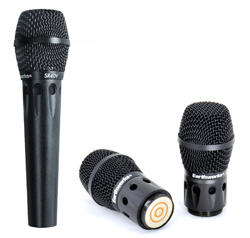
With an analog Shure UHR system, there was a slight anomaly centered around 250 Hz in the wireless version, which a wide-Q, -3 dB equalization corrected. This effect may have been introduced during the wireless modulation or demodulation. No EQ adjustments at any other frequencies were necessary to match the responses.
I also supplied the SR40V and WL40V for evaluation by Kevin Windrem of Sweet Spot Sound (Grass Valley, CA ), and he summarized his observations for me. Kevin had not yet tried the Earthworks microphone, and his favorite vocal microphone is the Neumann KMS 105, and he notes that unlike most vocal mics, it has no presence peak.
“Most vocal mics with a ‘mechanical’ presence peak are so ragged that they can’t be removed with EQ and the ‘gnarliness’ remains,” Kevin notes. “Not so with the SR40V. It’s presence peak is smooth and well controlled, so removing it with EQ is simple. I can make the Earthworks sound substantially the same as the KMS 105 with modest EQ – or visa-versa. Both the wired and wireless versions have a very consistent on-axis versus off-access response.”
Both versions were also used at the main arena stage for the 2012 Monterey Jazz Festival. Nick Malgieri of McCune Audio was the house engineer for the three-day outdoor event. The wired version was used for lead vocals during Eddie Palmieri’s show on the first evening, with the vocals clear and present throughout the show. Nick applied no EQ on the mic other than a high-pass filter at approximately 150 Hz to control stage bleed.
The SR40V was also used as the talk mic for Gordon Goodwin”s Big Phat Band, and during the Monterey Jazz Festival On Tour set. The wireless version was the announce mic for all the shows.
After the shows were over, he shared his impressions: “I feel comfortable saying that the Earthworks mic is easily in the same league with my other favorite vocal mics (Neumann KMS 104, Audio-Technica AT 4055, Shure KSM9). I found it to be transparent and airy, without any of the treble coloration often associated with other mics of the genre.”
Conclusion
The SR40V and WL40V both provide studio-quality, detailed vocal reproduction in a live setting. The attention to design and manufacturing details makes this a superior microphone, and in the tests it lived up to its ambitious specifications. And both carry a 15-year limited warranty.
This quality does come at a price – the SR40V wired vocal mic lists at $1,499, while the WL40V wireless version is $1,399. But if you’re serious about achieving the best live audio reproduction, with an extremely well-behaved and transparent microphone, it is worth the investment.
Note: To check out comments from the community as well as to ask questions about the SR40V and WL40V, go to the Road Test Forum here on PSW.
Gary Parks has served as marketing manager and wireless product manager for Clear-Com Intercom Systems, and also handled RF planning software sales with EDX Wireless in addition to doing loudspeaker and wireless product management at Electro-Voice.
